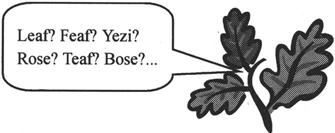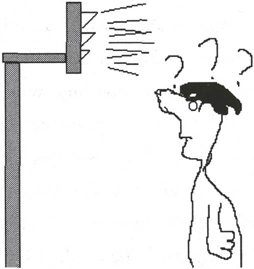




Sapir (1921: 8) gave a definition of language that sees it as a social and arbitrary communication system:
Language is a purely human and non-instinctive method of communicating ideas, emotions and desires by means of voluntarily produced symbols.
NON-INSTINCTIVE here implies convention, i. e. as users of a language, we all agree to call a certain thing in a certain name. We use "rose" to refer to the kind of flower that is thorny, fragrant and lovely-looking. Here, rose is used instead of "bose" or any other name because of the convention—the starting point of which being arbitrary. There is no connection between the sound "rose" and the flower it represents at the very beginning.
The ARBITRARINESS of language is a key feature that makes it different from other signs that we are familiar with in daily life. Dailylife signs can have different degrees of ICONICITY.
For instance, many signs contain a pictorial connection with the thing they represent. The road traffic signs warns us of crossroads, slippery road, traffic lights and pedestrian crossing. There is a clear pictorial link with the meanings. Such signs are called ICONIC by Peirce (1931—1958). On computer desktop we have all kinds of icons like a dustbin for "recycling" and a file folder for "file". What about letter "e" with a circle for Internet Explorer?
Peirce's second type of signs is INDEXICAL, i. e. it is partly motivated to the extent that there is a connection, usually of causality, between SIGN and REFERENT. For example, smoke is indexical of fire, spots on the skin indexical of disease like measles, and dark clouds indexical of the coming rain. Can you state the countries that are frequently identified by the following signs: bear, maple leaf, pyramids, kangaroo and red dragon?
Peirce's third type of signs is SYMBOLIC. The word in language, the formula in mathematics are all arbitrary. To come back to rose, "A rose is still a rose by any other name." — There is only half truth in this familiar saying. Why is that? Because a rose (red, with thorns, fragrant, beautiful layered petals) has to be a "rose" (pronounced as [rouz] and spelled as r-o-s-e). If it has other names, they must be agreed by the people who speak the language. For example, if we agree to call a rose a "love-flower", or a "bose". The key word here is "agree"; in other words, CONVENTION. The relationship between sound and meaning is set by convention. In still another word, linguistically, we call this relationship arbitrary. There is no good reason why a rose should be called a rose, but not a "bose" or "raze". If you think "rose" sounds like the proper name for that beautiful flower, this is because you have got used to the arbitrariness and readily accept the convention.

Fig. 1-1 Why do you call it "leaf"?
In short, arbitrariness means that the relationship between sound and meaning has no rational basis. Or there is no natural and inevitable link between the sound and the meaning it signifies.
Given that any language requires a complex set of arbitrary choices regarding sounds, words, and syntax, it is clear that the foundation of a language lies not in any "natural" meaning or appropriateness of its features, but in its system of rules—the implicit agreement among speakers that they will use certain sounds consistently, ... and that they will observe certain grammatical patterns in order to convey messages. It takes thousands of such rules to make up a language. Many linguists believe that when each of us learned these countless rules, as very young children, we accomplished the most complex cognitive task of our lives. (Clark et al, 1985: 21)
Now suppose you are a native English speaker. As you grow up, you learn how to change regular verbs to their past tense forms. There must be a period in your life (about four years old) when you would say "taked" and "goed". People around you have no problem understanding you. However, you would not use them this way today even if you think "goed" is a rational form of past tense. Why?
As Hudson points out, "Such conformity goes well beyond the needs of efficient communication and is motivated, apparently, only by the desire to be the same as everyone else, down to the finest detail" (Hudson, 1995: 35). So don't you think linguistics can tell us not only about language itself, but also about what we are as human beings?
Duality might be more accurately called multi-layeredness. The lowest level of language is phonetics. The English sounds themselves are limited in number, but once they combine to form words, there could be endless words. Words can combine to form endless sentences. As for sentences, they can combine to form endless texts. If we compare this feature of the human language with animal languages, we can see the latter lack such duality. A cat's mew and a monkey's pose can mean something—most likely in a primitive one-to-one correspondence way. Let us take another instance of the traffic lights. The language of the traffic lights does not have duality, as "red" means "stop" and "green" means "go". These low level elements—the colors of the lights are given specific meaning and they cannot form high-level meanings by combining "red + green" or "red + yellow + green".

Fig. 1-2 What does it mean— "red + yellow + green"?

When our new experiences call on us to express, we can always think of things never heard of before to say. We take this PRODUCTIVITY for granted. In fact it is one of the things that make human languages unique.
We learn words as building blocks of sentences, and a certain amount of vocabulary will enable us to communicate at a minimum level. Why is it we do not learn sentences? True there are some sentence patterns we must learn. But it is impossible for us to learn sentences in an exhaustive way, if we take into consideration the productive nature of language. We can speak an endless number of sentences with a limited vocabulary, and one sentence can expand into endless theoretically possible sentences in the way of recurring. E. g.
He came into a room that had a big shelf which was full of books which were covered by thick layers of magazines which were put there by the lady who used to ...
In fact, this is how Chomsky undertakes to study the nature of language, namely, by starting from its inventiveness.
A university professor in the US has made an interesting experiment. He showed a simple cartoon to 25 people and asked them to describe it using one sentence. He got 25 different answers. Then he input the result into his computer program, which is designed to work out how many grammatically correct sentences can be organized using the words in the 25 sentences. The answer is 198 billion possibilities. Similarly, 20 English words can make the number of possible sentences which if said aloud will call for one hundred thousand years' time—2000 times the age of the earth (Cogswell, 1996/1998: 61).
A kitten grown up among human beings speaks no human language. It says "meow". Its "language" is determined by the genetic makeup instead of the cultural context it happens to be in. But human child grows up speaking the language he hears in his immediate surroundings. Human language is transmitted by the culture we live in, not by parents. If the Chinese infant is adopted by an Italian couple living in Italy, he or she will grow up speaking perfect Italian.
That language is culturally transmitted can reveal a lot about our humanity.